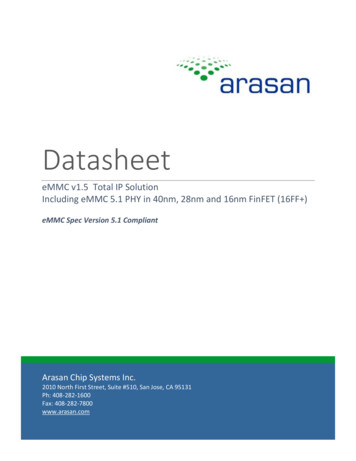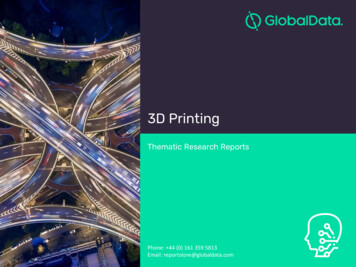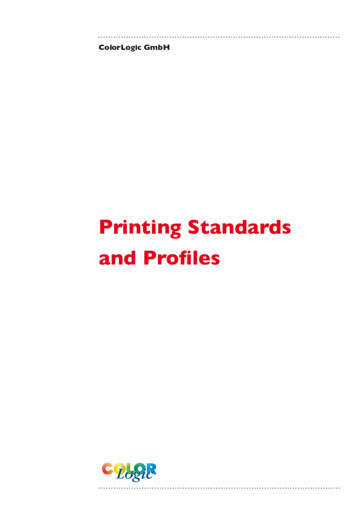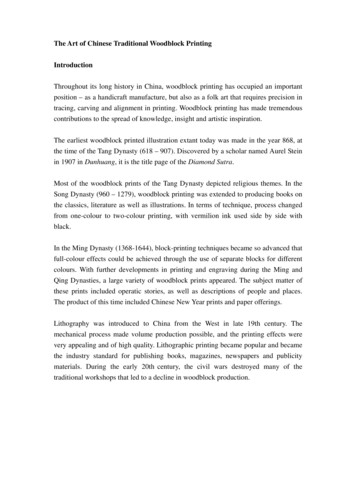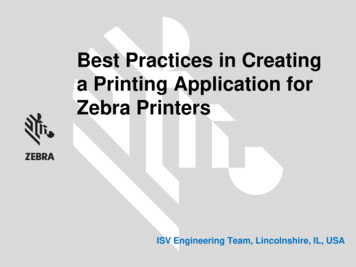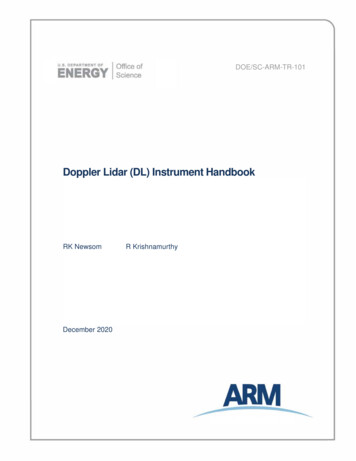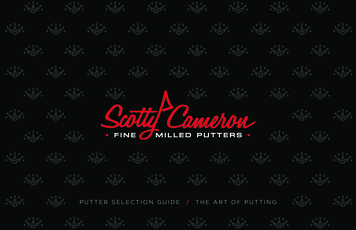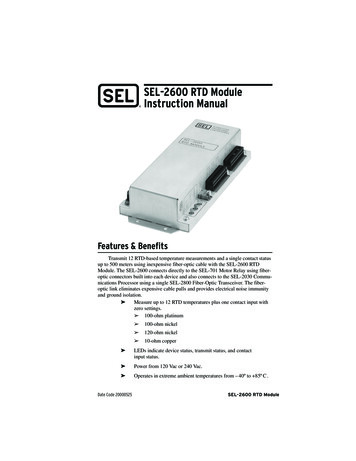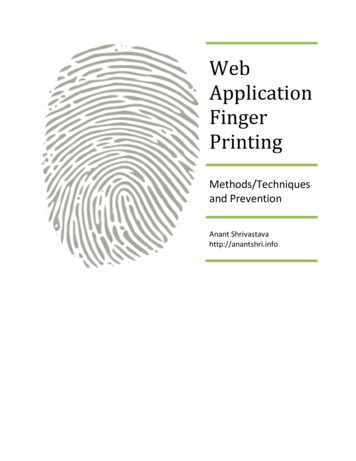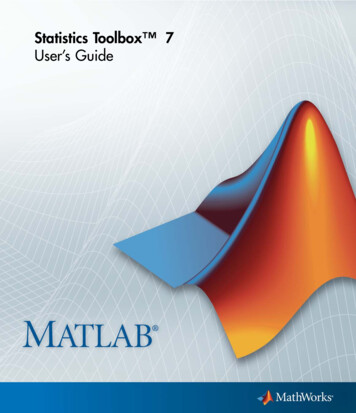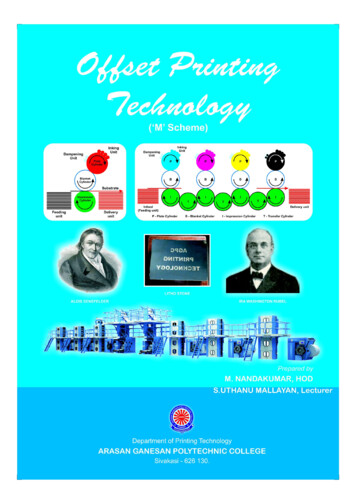
Transcription
OFFSET PRINTINGTECHNOLOGY
PREFACEThis book of Offset Printing Technology covers all the topics in a clear andorganized format for the Second year Diploma in Printing Technology students asprescribed by the Directorate of Technical Education, Chennai, Tamilnadu. It isconfidently believed that this book furnishes the students the necessary studymaterial. The topics covered were neatly illustrated for better understanding of thestudents.The book is prepared step-by-step lessons in large, eye pleasing calligraphymake it suitable for both direct one-to-one tutoring and regular classroom use. Thehighlight of this book is its simple English with clear and easy explanation of eachtopic.All the topics are explained with supporting diagram for diploma level studentsto understand effectively.This book majorly deals with Introduction to Sheetfed Offset Presses, SheetControl and Delivery in Offset Press, Printing Unit in Offset Press, Webfed OffsetPress – Infeed and Web Guiding Devices and Webfed Offset Press – Delivery Unitetc.Dr. M.Nandakumar, HOD / Print. TechS.Uthanu Mallayan, Lecturer / Print. TechArasan Ganesan Polytechnic CollegeSivakasi.
OFFSET PRINTING TECHNOLOGYDETAILED SYLLABUSUnitIName of the TopicIntroduction to Sheetfed Offset PressesHours12 Hrs.1.1 - Principles of Lithography and offset printing.1.2 - Units of offset machine – Feeding unit, Printing unit andDelivery unit.1.3 - Configuration and Structure of Sheetfed Presses: Singlecolor, Multi color and convertible presses.1.4 - Type of Presses: Inline Press, Stack Press, Blanket-toBlanket Press and Common Impression cylinder Press.IISheet Control and Delivery in Offset Press13 Hrs.2.1 - Types of Feeders – Friction feeders and Suction feeders,Types of Suction Feeders – Single sheet feeder and StreamFeeder.2.2 - Feeder Head Components – Feeder Head, Air blast Nozzle,Rear Pickup Suckers, Forwarding Pickup Suckers, SheetSteadiers, Separator Brushes and fingers. Feed boardelements – metal wheel, rubber tyred wheel, brush wheels,tapes and ball smoothener.2.3 - Sheet Registering Devices – Front lay and Sidelay, Types ofFront lay and Side lay. Sheet detectors – double sheet, nosheet and cross sheet detectors.2.4 - Sheet Insertions Devices – Swing arm, Rotary, Tumbler andOverfeed Grippers.2.5 - Delivery Section – Delivery Assist Devices, Suction Slowdown Rollers, Blow downs, Wedges, Skeleton Wheels, StarWheels and Anti set-off devices.2.6 - Make ready operations in offset printing machines andSafety precautions in press room.IIIPrinting Unit in Offset Press3.1 - Construction and functions of Plate Cylinder, BlanketCylinder, Impression Cylinder, Transfer Cylinder andDelivery Cylinder.3.2 - Types of Blankets: Conventional blanket and Compressibleblanket.3.3 - Inking System – Construction, Roller setting methods: FormRoller to Oscillator and Form Roller to Plate.3.4 - Inking System Problems - Roller Streaks and GlazedRollers.3.5 - Dampening System – Construction, Composition ofDampening Solution - pH, Conductivity and Dampeningsystem Roller setting. Types of Dampening System:Conventional or Intermittent, Continuous dampening system14 Hrs.
and Dahlgren dampening system.IVWebfed Offset Press – Infeed and Web Guiding Devices13 Hrs.4.1 - Historical development of webfed offset presses. Types ofReel Stands – Single reel stands, Double reel stands andThree reel stands.4.2 - Automatic Splicers – Zero Speed Paster ,Working Principleand function of Zero Speed paster, Purpose of Festoon.Flying Paster – Working Principle and function of Flyingpaster.4.3 - Web Control – Dancer Roller, Metering Roller, Box Tilt, Webbreak detectors and Bustle Wheel.VWebfed Offset Press – Delivery Unit5.1 - Types of Dryers – Open flame, High Velocity Hot Air andCombination Dryer, Chill Rollers – Early stage Chill rolls,Baffle plate Chill rolls and Jacketed Chill rolls.5.2 - Types of Folders – Former folder, Double Former Folder,Jaw Folder, Chopper Folder, Combination Folder andRibbon Folder.5.3 - Auxiliary Equipments – Stackers, Bundlers, Sheeters,Perforators and Imprinters.13 Hrs.
Offset Printing TechnologyUNIT – IINTRODUCTION TO SHEETFED OFFSET PRESSHistory of Offset Lithographic ProcessThe main planographic process in commercial use today is lithography, a wordderived from two Greek works: ‘lithos’ a stone; and ‘graphing’, to write. Literally, the wordmeans ‘stone writing’. This method of printing from a level surface, made its appearancelong after letterpress. It dates 1798 when it was discovered and applied by Alois Senefelderin Bavaria. His discovery depended on the principle that ‘grease and water do not mix’.The artist could draw or transfer the design or lettering directly on to the stonewithout any limitations of the hand engraver. Later, it was found that the thick stone couldbe replaced by a thin metal plate (zinc or aluminium) or even a plastic or paper one,capable of being curved around a cylinder on a rotary press. The application of photographyto the process provided a means of obtaining a printing image without drawing ortransferring by hand.1.1 PRINCIPLES OF LITHOGRAPHY AND OFFSET PRINTINGPrinciple of lithography is that ‘ink and water do not mix. This is an indirect process.In this process the image and non image areas are in the same level. The image areas areoleophilic (ink receptive). The non image areas are hydrophilic (water receptive). Beforecoming to the printing department the plate is made to oil and water receptive in the platemaking section by chemical treatment. During printing, first the dampening solution isapplied over the plate surface, the non image areas only receive the dampening solution.Then ink is applied by the inking roller over the plate surface. The dampening solutionpresent in the non image areas does not allow the ink to form over the non-image areas.The ink is only received by the image areas. During printing the image with ink istransferred to the paper by pressure.1.2 PRINCIPLE OF OFFSET PRINTINGOffset printing is a commonly used printing technique in which the inked image istransferred (or "offset") from a plate to a rubber blanket, then to the printing surface. Whenused in combination with the lithographic process, which is based on the repulsionof oil and water, the offset technique employs a flat (planographic) image carrier on whichthe image to be printed obtains ink from ink rollers, while the non-printing area attracts awater-based film (called "fountain solution"), keeping the non-printing areas ons:in1875by RobertBarclay of England for printing on tin. In 1904 by Ira Washington Rubel of the United Statesprinted on paper with offset principle which later becomes very famous.1AGPC, Sivakasi
Offset Printing Technology1.2.1 UNITS OF OFFSET MACHINE:A sheetfed offset press consists of the following units:1. Feeding Unit2. Printing Unit3. Inking Unit4. Dampening Unit5. Delivery Unit.1.2.2 Feeding Unit:The feeding unit is used to feed the paper into the printing unit. A feeding unitconsists of the following parts,1. Suckers: Suckers are used to suck the sheets one by one for transporting thesheets for printing. The suckers are of two types a)Lifiting suckers b) Forwarding suckers.2. Blowers: Blowers blows the stream of air to separate the sheets for sucking.3. Sheet separation strips: These strips are flexible fingers present at the feederhead to avoid the passage double sheet during sucking and forwarding.4. Pile board: This is the board present to stack the unprinted papers for printing.Over the pile board the feeder head is present.5. Feed board: This is present after the pileboard. Over the feedboard the sheettransportation devices are present to move the paper covering from the pileboard into theprinting unit. These parts are used to separate and forward the paper for printing.2AGPC, Sivakasi
Offset Printing Technology1.2.3 Printing Unit:A printing unit is a section of offset machine where the plate is inked and the inkedimage is transferred to the blanket from which it is finally transferred to the substrate.Printing unit consists of five elements:a) Plate Cylinder:This is the cylinder which holds the plate for printing. This cylinder is present overthe blanket cylinder. The inking and dampening system are present over plate cylinder.Dampening system applies the water and the inking system applies the ink on the platepresent over the plate cylinder and finally it gets applied over the paper.b) Blanket Cylinder:The blanket cylinder holds the resilient rubber blanket for printing on its surface. Theblanket cylinder is present between the plate and impression cylinder. During printing theblanket cylinder with blanket alone moves and contacts both the plate and impressioncylinder to receive the ink from the plate and to transfer the ink to the substrate whichpasses between the blanket and impression cylinder.c) Impression Cylinder:This cylinder is used to give impression to the substrate for the transfer of inkedimage from the blanket. This cylinder is present below the blanket cylinder. This cylindergives high pressure during the passage of paper.d) Inking System:The inking system have a number of inking rollers which are used to grain andsupply the ink from the ink duct to the plate. In the inking system the rubber rollers andmetal rollers are arranged alternatively for fine grinding of ink and to avoid roller wear. In theoffset machine multiroller inking system is present.e) Dampening System:The Dampening unit is also consist of a number of rollers which are used to receivethe dampening solution from the fountain duct and to transfer the dampening to the plate. Inthe dampening system the rubber roller are covered with cloth in order to store and supplythe dampening solution during printing. The dampening system is classified into two types,one is conventional dampening system and other one is continuous dampening system.1.2.4 Delivery Unit:This unit consists of a number of gripper bars which are used to transfer the printingpaper from the impression cylinder grippers to the delivery unit pile board. In the deliveryunit with the help of rear joggers, side joggers, front stopper and back stoppers the papersget delivered and neatly stacked in the pileboard. Apart from the devices in the delivery unit,3AGPC, Sivakasi
Offset Printing Technologysucktion slowdowns, blowdowns and skeleton wheels are also present for the support ofdelivery of paper. The delivery systems are of two types a) clute delivery b) chain delivery.1.3 CONFIGURATION AND STRUCTURE OF SHEETFED OFFSET PRESS:The configuration or structures of sheetfed offset presses are divided into thefollowing categories:a. Single color offset pressb. Multi color Sheet-fed pressesc. Convertible pressa) Single color offset press:A press consisting of a single printing unit, with its integral inking and dampeningsystems, a feeder, a sheet transfer system, and a delivery is called a single-color press.Normally, it can print only a single color in any one pass through the press. On somepresses, the inking system can be modified - split - with ink fountain ink roller dividers sothat two or more colors can be printed at one time. On these presses, the same printingplate is used, and the colors are widely separated.A single-color press can also be used for true multicolor printing, the printing of twoor more colors, often one over another. Multicolor printing on a single-color press requiresthat the sheet be fed through the press as many times as there are colors to be printed.After each printing, the just used plate is removed and the inking system is thoroughlycleaned. A new plate is mounted on the plate cylinder, and the inking system is filled withthe next color. The sheet of paper is run through the press again and printed with this newcolor. (Multicolor printing on a single-color press is dependent upon dry trapping -the abilityof a dry, printed ink film to accept a wet ink film over it. The wet ink dries by oxidation (or)polymerization).4AGPC, Sivakasi
Offset Printing Technologyb) Multi color Sheetfed presses:A press consisting of several printing units (each with its own inking and dampeningsystem), a feeder, a sheet transfer system, and a delivery is called a multicolor or multiunitpress. A multicolor press can have two, four, five, six, or more printing units. (Multicolorpresses are capable of wet trapping, the ability of a wet, printed ink film to accept anotherwet ink film printed over it).In the larger press sizes, the printing units are almost identical and are arranged intandem. With some of the other two-and four-color presses, one printing unit may be higherthan the other to obtain better accessibility.When placed in tandem, the open-unit type of single-color sheetfed press becomesa multicolor press, capable of printing a different color on each unit. One or more transfercylinders are placed between units to transport the sheet from one printing unit to the next.Some presses have three transfer cylinders between units, while other presses have asingle, double-size transfer cylinder. An odd number of transfer cylinders are neededbetween units so that the side of the sheet to be printed faces away from the impressioncylinder.1.3.3 Convertible pressThese presses are used to print in both sides of the paper in a single pass from thefeeding unit to the delivery unit. In this press two or more printing units are present. Afterprinting the first unit the paper gets turned to the next side by using special transfer cylinderfor printing in the next side of the paper by the second printing unit. Thus the paper getsprinted at both sides in the printing units. This is also one kind of perfecting press. Thispress may also be used as the normal offset machine for printing all the colors in one sideof the paper also.5AGPC, Sivakasi
Offset Printing Technology1.4 TYPES OF SHEETFED OFFSET PRESS:There are three types of sheetfed offset machine are present. They area. Inline pressb. Stack Type pressc. Blanket to Blanket Pressd. Common Impression Cylinder press.a) Inline press:This is the press in which all the printing units are arranged one after the other in aline. So the presses are called as the Inline presses. This Inline presses are non-perfectingtype. Because each unit only one Plate cylinder, Blanket cylinder and Impression cylinder.These presses occupies more space.6AGPC, Sivakasi
Offset Printing Technologyb) Stack Type Press:In this presses each printing unit is arranged vertically one over the other. In thispresses the printing units are arranged horizontally and the paper goes to vertically printing.This type of presses occupies less space because the printing units are arranged one onthe top of the other.c) Blanket to Blanket PressIn this presses no impression cylinder is present. In each unit only blanket and platecylinder is present. In this presses the blanket cylinder of unit acts as impression cylinder togive impression to the blanket cylinder of the next printing unit. These presses areotherwise called perfecting presses. In single pass of the paper, the paper gets printed atboth sides. These presses save time of production.7AGPC, Sivakasi
Offset Printing Technologyd) Common Impression Cylinder presses:In this type of press a large size of impression cylinder is present. Around theimpression cylinder two or more printing couples are arranged. The paper gets fed from oneside of the impression cylinder to the first printing unit and gets delivered from the lastprinting unit in the other side of the common impression cylinder. If the CIC presses consistof four or more than printing units around in its surface then this presses are called assatellite presses. If two printing units are arranged around a CIC presses then this pressesare called as semi-drum presses. The other name of the CIC presses the four printing unitsor more then this press is called as satellite press.8AGPC, Sivakasi
Offset Printing TechnologyQUESTIONSUnit - IPART – A (Two Marks Questions)1. What is the meaning of offset?The ink printing over the paper surface gets off into blanket from plate cylinder andfinally set on paper. (PlateBlanketPaper)2. What are the structures of sheetfed press? or What are the configurations ofsheetfed offset press?1. Single color sheetfed press.2. Multicolor sheetfed press.3. Perfecting press.3. What is perfecting?Printing on both sides of the paper in a single pass is called perfecting.4. State the purpose of Inking unit?Inking unit is to supply a very thin amount of ink to the plate for printing.5. What is an Inline press?In this press all the printing units are arranged in a line.6. What is stack type press?In this press the printing units are arranged one over the other.7. What is CIC press?In this press a large size common impression cylinder is present for giving pressureto the printing units present around the common impression cylinder.8. What is the other name of CIC press?Satellite press.9. What is semi-drum press?This is the press in which only two printing units are arranged around the CIC.10. What is single color offset machine?Single colour offset machine is capable of printing single colour in one pass. It hasone set of Plate cylinder, Blanket cylinder, Impression cylinder with Inking and Dampeningsystem.11. What are the units of offset press?1. Feeding unit.9AGPC, Sivakasi
Offset Printing Technology2. Printing unit.3. Inking unit.4. Dampening unit5. Delivery unit.12. What is a printing couple?In each printing couple a Plate cylinder, Blanket cylinder and Impression cylinderalong with an Inking system and Dampening system is present.13. What is the use of Plate cylinder?The Plate cylinder is used to hold the plate (image carrier) for printing.14. What is Blanket cylinder?The Blanket cylinder is used to hold the resilient blanket for printing.15. What is the purpose of Impression cylinder?The Impression cylinder is used for giving pressure to the blanket cylinder in order totransfer the ink to the paper.16. What is an image carrier?Image carrier holds the image over the surface to transfer the ink from its surface tothe paper.PART – B (Three Marks Questions)1. What is Oleophilic and Hydrophilic?Oleophilic means oil receptiveness of a material. Hydrophilic means waterreceptiveness of a material.2. What is the use of feeding unit and what are the types of sheetfed press?Feeding unit is used to feed the paper one after another for printing.1. Inline press.2. Stack Type press.3. Blanket to blanket press.4. Common Impression Cylinder press.3. What is multi color offset press?Multi colour press is capable of printing multi colour. It has two or four or more set ofPlate cylinder, Blanket cylinder, Impression cylinder with Inking and Dampening system toprint multi colour in single pass.4. What is the use of transfer cylinder?10AGPC, Sivakasi
Offset Printing TechnologyTransfer cylinder is present between two printing units which are used to transfer theprinted sheet from the first unit to the next unit.5. What is convertible offset press?These presses are used to print in both sides of the paper in a single pass from thefeeding unit to the delivery unit. In this press two or more printing units are present. Afterprinting the first unit the paper gets turned to the next side by using special transfer cylinderfor printing in the next side of the paper by the second printing unit. Thus the paper getsprinted at both sides in the printing units.PART – C (Ten Marks Questions)1. Explain the units of offset printing with neat sketch.2. Explain the construction of sheetfed press with neat sketch?3. Explain the configuration (or) structure of sheetfed- offset presses with neat sketches?4. What are the types of offset presses? And explain any one with neat sketch.5. Explain the working principle of single clour offset press with neat sketch.6. Explain the working principle of multi clour offset press with neat sketch.7. Explain the working principle of convertible offset press with neat sketch.8. Explain the working principle of inline offset press with neat sketch.9. Explain the working principle of stack type offset press with neat sketch.10. Explain the working principle of blanket to blanket offset press with neat sketch.11. Explain the working principle of common impression cylinder offset press with neatsketch.11AGPC, Sivakasi
Offset Printing TechnologyUNIT- II2. SHEET CONTROL AND DELIVERY IN OFFSET PRESSSheet control means separating the sheet from the pile board and transporting thesheet one by one into the printing unit in correct print registration. The sheet control devicesare blowers, suckers, infeed wheels, brush wheels, metal wheels, rubber wheels, side lay,front lay and infeed wheels.2.1 Types of Feeders1. Friction feeders2. Suction feeders (Single sheet feeder and Stream)Automatic sheet feeder are the feeders which automatically separate the sheetsfrom the pile board and transfer the sheets into the printing unit. The automatic feeders areclassified into friction feeder and suction feeder.2.1.1 Friction feeder:Friction feeder feeds the sheets one by one by means of friction devices. Frictionfeeding is mainly used in small offset duplicators. This is also used in folding machines.In the friction feeder there is a set of retaining spring clips. These clips catch thefront or leading edge of the pile of paper. This finger avoids the passing of more than onesheet into the machine. The friction draw bar and control rod also present in these feeders.The control rod is also acts as the pile height governor. The friction draw bar and control rodare involved in feeding the paper into the machine.12AGPC, Sivakasi
Offset Printing TechnologyFirst the friction draw bar and control rod both moves downwards and presses thetop of the pile. The control rod remains in its place but the friction draw bar moves towardsthe control rod by releasing the topmost sheet of the pile from the retaining clips. At thesame time as the control rod is stationary, a buckle will be formed in the sheet. So, only onesheet will be separated due to the buckle forms. Now the control rod moves upwards to itsoriginal position. But the friction draw bar moves towards the retaining clips thus moving theseparated sheet over the clips. The friction draw bar will move until the leading edge of thesheet is inserted into the nip of the forwarding rollers. Then the friction draw bar will movesto its original position for the next cycle.The metal strips are used in the feeder head which are used to avoid the passing ofdouble sheet going for printing during sheet separation.13AGPC, Sivakasi
Offset Printing Technology2.1.2 Types of Suction or Pneumatic Feeder:This type of feeders is operated with the help of air supply. The suction or pneumaticfeeders are divided into two types:1. Single sheet feeder or Successive sheet feeder2. Stream feeder or Continuous feeder.Types of Automatic feederThe automatic feeders are divided into types,1. Single sheet feeder or Successive sheet feeder2. Stream feeder or Continuous feeder.2.1.3 Single sheet feeder or Successive sheet feeder:This feeder is present in the machine which is working with front separationprinciple. The speed of the front separation machine is slow when compared to the speed of14AGPC, Sivakasi
Offset Printing Technologythe back separation machine, because in front separation machine the sheet has to bewaiting for sometime to allow the full sheet to cross the front separation suckers. Examplefor front separation machine is mini offset machine.The working sequence of single sheet feeder is as follows:1. The pile height governor senses the height of the pile and automaticallyraises it to predetermined position.2. The air nozzles situated at the front and rear side’s forces the air into the toppile partially separating them.3. The front suckers descend and take hold of the first sheet.4. The forwarding suckers lift and the sheet is moved forward suckers until theleading edge of the sheet is between the rollers.5. The forwarding rollers close on to the sheet and it is conveyed to the feedboard.The single sheet feeder is generally found on smaller presses which run about thespeed of about 6000 IPH.2.1.4 Stream Feeder:These types of feeders are present in the machine which is operated by backseparation principle.The speed of the stream feeder machine is high when compared to the speed ofsingle sheet feeding machine because the feeder head is present at the back edge of thepaper present in the pile board. So the suckers do not able to wait for the full sheet passing.The stream feeders are present in the general offset machines as well as high speedmachines.The sequence of operation of stream feeder is as follows:1. Air is forced into the back edge of the pile separating the top sheets. Therear suckers descend and take hold of the top floating sheet.2. The sucker’s raises the back edge of the sheet and the hold down footdescends to firmly hold the remaining sheets to the pole. This hold downfootoften acts as the pile height governor.3. A steam of high velocity air is now directed under the top sheet, lifting thefront edge to level with the forwarding rollers.4. The sheet is now moved forward by cushion of air to pass between theforwarding rollers and the drop wheels which close on to the sheet andconvey to forward. As the sheet is taken by the forwarding roller, the backseparation unit begins its next cycle.15AGPC, Sivakasi
Offset Printing Technology2.2 Feeder head components:This is the part of the feeding unit present above the pile board. It consists of thecomponents which are used to separate and to forward the sheets one by one for printing.The feeder head components are:a. Air blast nozzlesb. Rear pickup suckers (Lifting Suckers)c. Forwarding pick up suckers (Forwarding suckers)d. Lifting and forwarding suckers or Rear pick up and forwarding suckerse. Brushesf.Metal strips or metal fingers or sheet separation stripsg. Sheet steadiersFeeder head components:The devices which are present in the feeder head are called feeder components.The feeder head components are air blast nozzles, rear pickup suckers, sheet steadiers,separation brushes and fingers.1. Air blast nozzles :16AGPC, Sivakasi
Offset Printing TechnologyThis component is present at the feeder head and used to blow forced air at theback edge of the pile board where the pile of paper is present. The air lifts the paper at theback edge which helps for the separation of single sheet for printing.2. Rear pickup suckers (Lifting Suckers):This is the suckers present in the machine which works by back separation principle.This sucker sucks the air to separate the sheets in the pile board at the back edge. Theother name of the rear pick up suckers is called lifting suckers.3. Forwarding pick up suckers (Forwarding suckers):These are the suckers present after the rear pick up suckers which receives thepaper from the lifting suckers and forward the received sheets one after one over the feedboard area.4. Lifting and forwarding suckers or Rear pick up and forwarding suckers:These suckers are also present at the back edge of the paper at the pile board.These suckers perform both the lifting and forwarding operations on the paper. So thesesuckers are called as lifting and forwarding suckers.5. Brushes:The brushes are used in the feeder head which are used to avoid the passing ofdouble sheet for printing during sheet separation operation. The bristles of the brushesenter into the lifted papers and help to avoid the suction of double sheets for printing.6. Metal strips or metal fingers or sheet separation strips:These are the flexible metal fingers which contacts the back edge of the pile ofpaper. These strips are used to avoid the passage of double sheets going for printing.Sheet Steadiers:The sheet steadiers are present in the feeder head and it is provided in a mannerthat its flat edge contacts in the two side edges and rear edge of the stacked paper to avoidthe displacement of paper during lifting and forwarding operation. These sheet steadiersare having up and down movement.17AGPC, Sivakasi
Offset Printing TechnologySheet forwarding devices:These are the devices which are used to transport the sheets one by one from thepile board area over the feed board to the front lay for registration. The forwarding suckersare given as follows:1. Forwarding suckers:These suckers receives the sheet from the lifting suckers and forwards the receivedsheets into the feed board2. Conveyor tapes:These endless belts are made of hard – wear material. These are Connected withthe shaft at the front and back edge of the feed board. These are present in correct tensionfor helping the tensioning rollers for free movement.3. Running - in wheels (Brush wheels):These wheels must be positioned over the conveyor tape and tensioned for givingcorrect pressure to the sheets for movement over the feed board.18AGPC, Sivakasi
Offset Printing Technology4. Conveyor assemblies:Two or more feed board rails are situated over the feed board. The Running inwheels, brush wheels and ball assemblies are attached to the rails by movable clamps.5. Forwarding rollers(metal wheel or rubber type wheel):These rollers are present over the rotating shaft. These are used to transport thesheets from the pile board to the feed board.6. Ball Smoothners:Ball smoothners are positioned over the conveyor tape to hold the paper on thefeedboard firmly. Ball smoothners rotates at 360 0 angle which allows the paper to movefront and side ways.19AGPC, Sivakasi
Offset Printing Technology3.3 Sheet registering devices:These are the devices present in the feed board which is used to register the sheetsin the front and side edges to pass the sheet in a square for the correct positioning of imageon the sheets.The sheet registering devices are classifie
A printing unit is a section of offset machine where the plate is inked and the inked image is transferred to the blanket from which it is finally transferred to the substrate. Printing unit consists of five elements: a) Plate Cylinder: This is the cylinder which holds the plate for printing. This cylinder is present over
